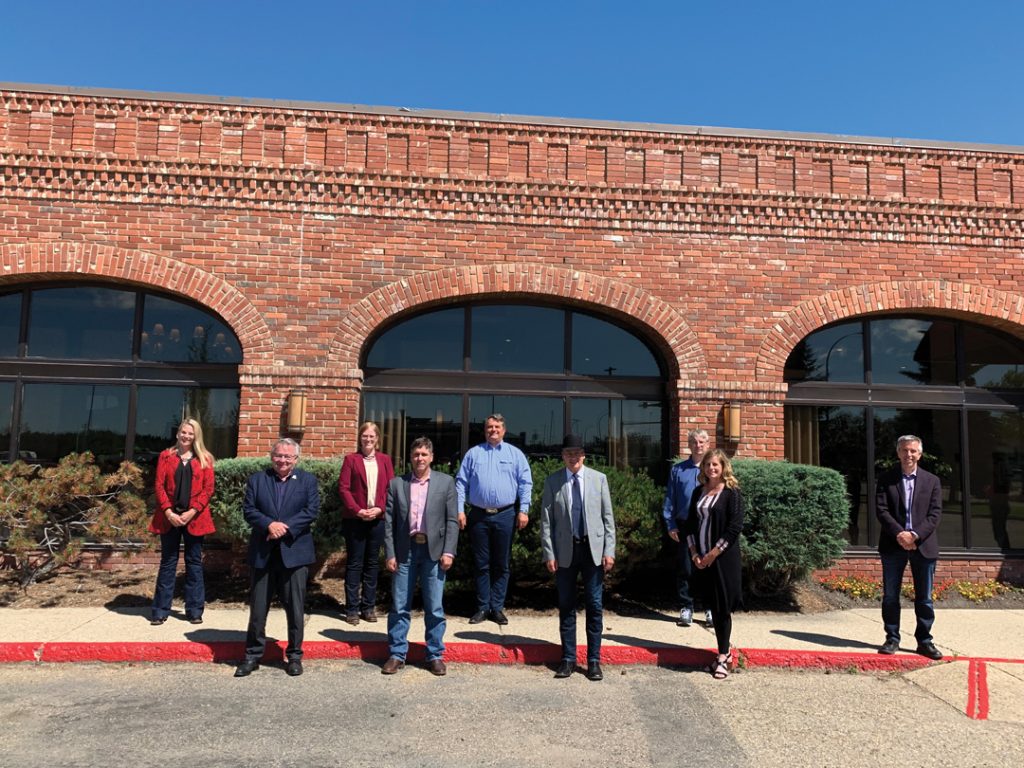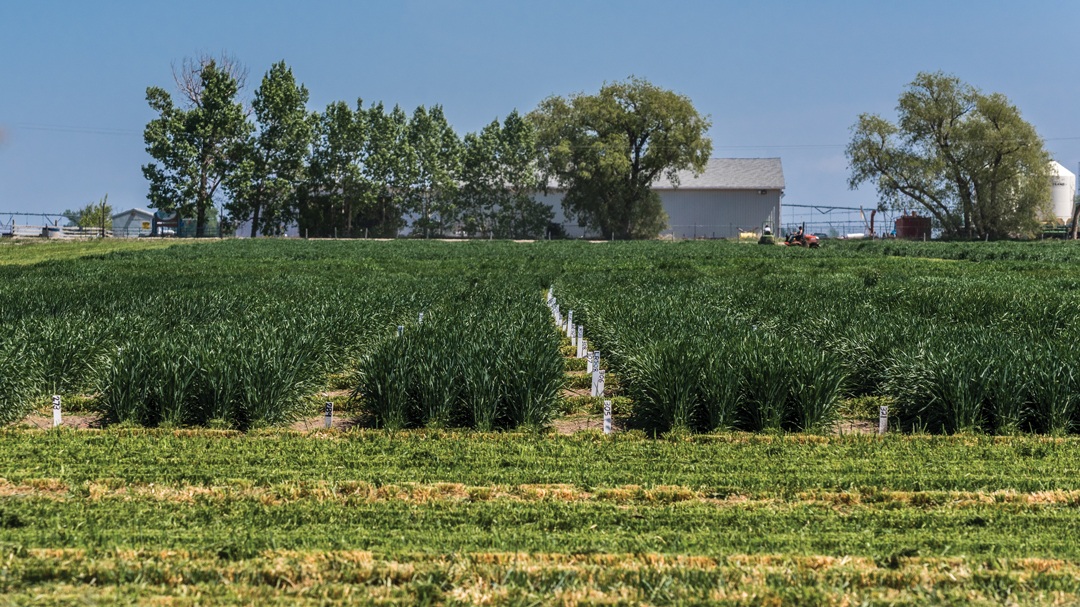RESEARCH RESET
BY CULLEN BIRD • PHOTO COURTESY OF AGRICULTURE AND AGRI-FOOD CANADA LETHBRIDGE RESEARCH AND DEVELOPMENT STATION
When the UCP took power following the 2019 provincial election, the party did so with a laundry list of campaign promises made to Alberta’s agriculture sector. One of these was to listen to farmers for direction on agricultural research. Post-election, the government embarked on a series of consultation sessions in the winter of 2020 to gain a sense of what farmers wanted from publicly funded ag research.
“We asked them what farmer-led research meant to actual farmers and ranchers throughout Alberta, and through those consultations, we developed the structure of RDAR, of the Results Driven Agriculture Research organization,” said Minister of Agriculture and Forestry Devin Dreeshen.
The government created RDAR to implement the new approach to agricultural research and appointed a nine-member interim board to launch the non-profit company. RDAR’s mandate is to “support results-driven agriculture research priorities and programs that will increase competitiveness and profitability of Alberta’s agriculture industry.”
At arm’s-length from government, RDAR will annually administer $37 million in research funding. It has been granted $2 million by the Canadian Agricultural Partnership (CAP) to cover startup and overhead costs. These startup funds were administered by Alberta Barley. “From farmers and farm groups that I’ve talked to, they seem very excited that there is this significant commitment to public research in agriculture in Alberta,” said Dreeshen.
RDAR’s arm’s-length nature will take politics out of research funding decisions, believes David Chalack, interim board chair. “We’re a flat, lean, mean organization, with a board that represents producers and answers to producers, because the membership is made up of producers,” said Chalack.
RESPONSE TO FARMERS
Chalack, a large animal veterinarian, was the chair of the Alberta Livestock and Meat Agency at the time of its dissolution under the NDP government in 2015. The NDP also later dissolved the Alberta Crop Industry Development Fund and moved the research responsibilities of both entities within Alberta Agriculture and Forestry (AF). However, the shift prompted industry complaints about the research funding approval process. Critics cited poor communication and accountability and questioned funding choices.
“When things were taken into the ministry, we lost track of how decisions were being made and whom those decisions were made by,” said Lauren Comin, Alberta Wheat Commission (AWC) research director. Typically, the ministry wouldn’t make its research interests known or share funding timelines until it was too late, she said. Because AWC does its own share of research funding, RDAR offers an opportunity for co-funding. “We’re looking for a transparent partner in co-funding,” said Comin.
When the NDP came to power in 2015, they created a draft plan to change the research strategy for the ministry, Comin said. Sustainability and climate change were priorities stressed in the draft plan, which was not finalized before the government changed again in 2019.
It seemed that to receive funding, research applications had to be tied to lowering carbon emissions or other environmental causes, said Chalack. The research of carbon use and the environment in agriculture is a good thing, he added, but it’s not the only thing. There was enough dissatisfaction in the farming community over this it became a political issue, he said. Government press releases about RDAR have emphasized government shouldn’t bend research priorities to suit ideology.
The RDAR model is largely based on a white paper authored by Comin that advocated for the creation of an arm’s length agency directed by farmers that would set research priorities.

A NEW RESEARCH ENTITY
RDAR is now overseen by its interim board of directors appointed by Dreeshen. Tom Steve, Alberta Wheat and Barley Commissions general manager, is vice-chair of RDAR’s interim board. The organization’s 33 voting members represent farm groups and industry associations. An 11-member permanent board will be elected by voting members in the first quarter of 2021. Crop and livestock groups will nominate seven board members, while candidates for the remaining four seats will be nominated by the board based on expertise and skill sets yet to be determined. Interim board members may stand for election to the permanent board.
The RDAR board will be assisted by a 50-member advisory committee made up of farmers and representatives of postsecondary institutions and other research entities. Steve is co-chair of the advisory committee. An industry co-chair will be chosen from the advisory committee members. The committee will have no governing power but will provide expertise and advice to the board.
“We recognize that for RDAR and this advisory committee to be successful, we need everyone to understand that they need to take a broad view of agriculture,” said Chalack. “There has to be a willingness to come to a consensus.”
The advisory committee held a series of sessions over a three-week period in late August to develop RDAR’s initial research priorities, which are mainly focused on the productivity and competitiveness of Alberta’s agriculture industry. “We had close to 100 per cent participation in the committee from the 50 member groups at the beginning of harvest, which tells us there is strong support for this groundbreaking model for ag research,” said Steve. The initial priorities were adopted by the RDAR board.
NIP AND TUCK
The establishment of RDAR comes against a backdrop of cuts to AF. About 50 extension staff and researchers were let go in December 2019. A further 277 positions were slated to be cut by Oct. 15 of this year.
“We have identified areas in which we think we can offer front-line services better or areas of the department that weren’t performing,” said Dreeshen. However, the pandemic has delayed ongoing union negotiations around the cuts. “The efficiencies have still been identified and we’re going to make them, but the timing of it now is unknown just because of the delays in all those negotiations,” he said.
“We’ve just gone through a period where the provincial government has laid off a lot of research scientists and their staff,” said Lynn Jacobson, president of the Alberta Federation of Agriculture and RDAR member. “We didn’t really agree with that move as a general farm organization.” Jacobson is concerned the cuts may create gaps that will not be filled by RDAR. He cited the elimination of the government’s only forage research position in December 2019 as an example.
He also questioned the suggestion the previous research funding model was somehow compromised by political ideology. “We’re trying to figure out where some of these very essential scientific positions will land because provincial researchers have had a very Alberta-regional approach,” said Comin. In comparison, she said, federal researchers at Agriculture and Agri-Food Canada take a larger, Prairie-centric approach.
Covering any potential gaps will be up to RDAR, said Dreeshen. “The whole point of RDAR is that you’re not going to have politicians directing [farmers] on what kind of research should continue or is not going to continue,” he said.
“We will have to assess each plan and each opportunity on a case-by-case basis,” said Chalack about how RDAR will deal with research gaps that may emerge. He also addressed the question of whether RDAR will fund facilities and infrastructure. “We as a board have said we are not funding capital costs, like equipment and bricks and mortar,” said Chalack. However, it might be possible that RDAR will “inherit” facilities or infrastructure from AF, he said. “Those are ministerial decisions, and then the board assesses opportunities, gaps, requirements.”
TIME CRUNCH
RDAR’s timeline had called for the advisory committee to establish research priorities by September. RDAR is scheduled to accept research applications prior to the New Year. “We hope to have our first call out, hopefully, by November,” said Chalack. RDAR will judge every research application based on its merit, not by relative economic importance of the relevant sector, he added. RDAR will provide stable, long-term funding for multi-year research projects, he added.
As of August, crop groups and research entities were in the process of sending and reviewing funding applications. “As we get closer to December, funding decisions will have to be made,” said Comin. “Ideally, RDAR will be on the same schedule.” Chalack is adamant it will be. “We’ve set some deadlines, and we’ll meet them,” he said.
A VISION OF THE FUTURE
The uncertainty created by looming cuts to AF has caused concern within the province’s agriculture industry about what may be a rough transition. What’s certain is the shift to a new industry-led funding model administered by RDAR will mean the direction of ag research is squarely in the hands of farm groups.
“Our vision is that Alberta’s agriculture and food sectors achieve their full potential through producer-led strategic investments in research and innovation,” said Chalack. “There was lots of discussion on whether we should have added sustainability [to our vision]. We were rather forceful on competitiveness and profitability.”
Sustainability can have a broad definition, said Chalack. “To me, sustainability means value creation in a competitive marketplace. Unprofitable investments are unsustainable.”
For more information on RDAR, visit its temporary website: rdar.ca.
RDAR’S OPERATING PRINCIPLES
1. Be a highly respected, forward thinking leader in agriculture research funding
2. Invest in producer-led research priorities
3. Ensure knowledge transfer
4. Use resources efficiently; demonstrate fiscal responsibility
5. Enhance collaboration and optimize research capacity
6. Practice intentional and effective communication
7. Reflect a responsive and respectful governance model
8. Maximize commercial benefit of intellectual property







Comments